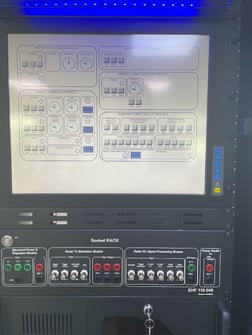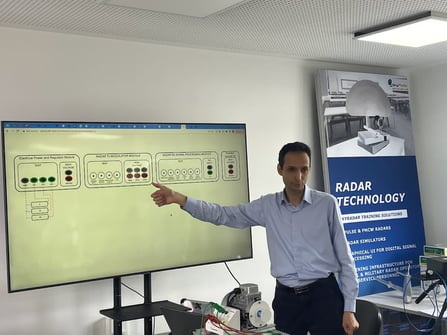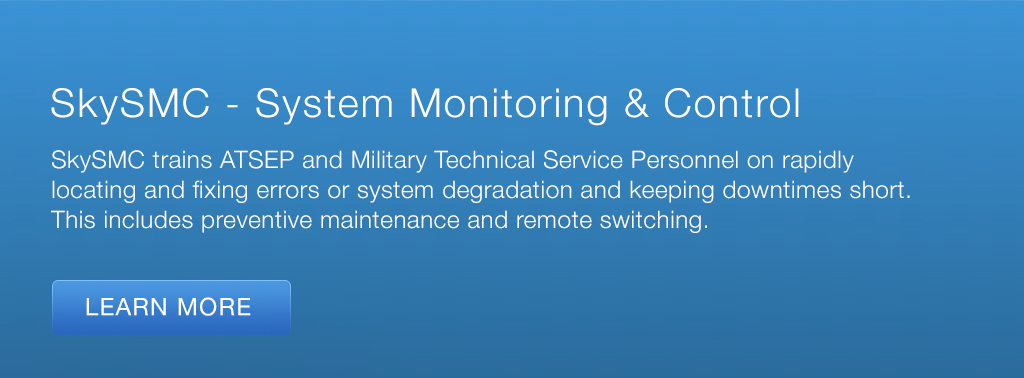Air Traffic Control (ATC) is a critical component of aviation, responsible for managing and directing the movement of aircraft. Effective communication between ATC and pilots is essential for safe and efficient air traffic management. However, errors in communication can have serious consequences, including incidents and accidents. One type of communication error that can occur is Transmitter Errors due to Stagger. This article will explore the impact of these errors on ATC and discuss steps that can be taken to prevent them.
Definition of Transmitter Errors due to Stagger
Transmitter Errors due to Stagger refer to errors in the timing of communication transmissions between aircraft and ATC. Stagger occurs when aircraft transmissions overlap with ATC transmissions, resulting in missed or garbled messages. This can occur when two or more aircraft transmit simultaneously, or when one aircraft transmits while another is still transmitting.
What is Stagger? Explain with an example
Stagger is a phenomenon that occurs when two or more transmissions occur simultaneously or when one transmission overlaps with another. For example, if two aircraft are communicating with ATC at the same time and their transmissions overlap, it can result in garbled or missed messages. Similarly, if one aircraft is still transmitting while another starts transmitting, it can also lead to missed or garbled messages.
Scenario that illustrates impact of Transmitter error related to Stagger Pulse on Air traffic Control Services
Scenario 1: Transmitter Stagger Error Causing Communication Disruptions
Imagine a scenario where an air traffic control center manages a busy airport with multiple runways and a high volume of aircraft movements. The center uses a sophisticated communication system with multiple transmitters that need to be precisely synchronized to ensure uninterrupted communication between controllers and pilots. However, due to a transmitter stagger error, the synchronization is disrupted.
Impact on Air Traffic Control Services
Communication Disruptions
The transmitter stagger error can cause intermittent disruptions in communication between the controllers and pilots. This can lead to delays in issuing critical instructions, such as takeoff and landing clearances, causing disruptions in flight schedules and congestion on the runways.
Increased Workload
The communication disruptions can increase the workload on the controllers. They may need to repeat instructions or make additional attempts to establish communication with the pilots, leading to fatigue and potential errors in managing aircraft movements.
Safety Risks
The communication disruptions can also pose safety risks to the aircraft in the vicinity. Pilots may miss critical instructions or misinterpret them, leading to misunderstandings, conflicts, or other hazardous situations.
Scenario 2: Transmitter Stagger Error Leading to Reduced Coverage
In another scenario, consider an air traffic control tower responsible for managing the air traffic in a remote location with limited coverage of communication systems. The tower relies on a set of transmitters to ensure reliable communication with aircraft within the coverage area. However, due to a transmitter stagger error, the coverage area is reduced.
Impact on Air Traffic Control Services
Coverage Limitations
The transmitter stagger error can cause coverage limitations, resulting in reduced communication range or dead spots within the coverage area. This can lead to difficulties in managing the aircraft movements within the affected areas, increasing the workload on the controllers and introducing potential safety risks.
Reduced Efficiency
The coverage limitations can also reduce the efficiency of air traffic control services. Controllers may need to use alternative communication methods, such as VHF radios, to communicate with the pilots, increasing the complexity of managing aircraft movements and potentially leading to delays and disruptions.
Safety Risks
The reduced coverage can also pose safety risks to the aircraft within the coverage area. Pilots may experience difficulties in communicating with the controllers, causing misunderstandings or misinterpretations of critical instructions, leading to hazardous situations.
In both scenarios, the transmitter stagger error highlights the critical importance of maintaining reliable and properly synchronized communication systems in air traffic control. It also emphasizes the need for regular inspections, monitoring, and maintenance of the communication equipment to prevent such errors and ensure safe and efficient air traffic management.
Factors Responsible for Stagger related Transmitter Errors
Several factors can contribute to Stagger related Transmitter Errors, including
High Traffic Volume
When the volume of air traffic is high, there is a greater likelihood of aircraft transmissions overlapping with ATC transmissions.
Radio Frequency Congestion
Radio frequency congestion can result in Stagger as aircraft and ATC transmissions compete for limited bandwidth.
Pilot Error
Pilots may inadvertently transmit at the wrong time or fail to wait for a clear channel before transmitting.
Equipment Malfunction
Faulty equipment or incorrect settings can cause transmissions to overlap or occur at the wrong time.
Some common types of Transmitter Errors caused by Stagger
Transmitter errors caused by stagger, also known as phase staggering, can lead to various issues in communication systems. Here are some common types of transmitter errors caused by stagger:
Interference and Crosstalk
Staggered transmission signals can result in interference and crosstalk between adjacent channels or transmission lines. This can lead to signal degradation, increased noise, and reduced signal quality, affecting the overall performance and reliability of the communication system.
Signal Distortion
Staggered transmitters can introduce signal distortion due to phase misalignment. This distortion can cause waveform deformation, leading to errors in signal decoding and data retrieval. It can result in reduced data accuracy and increased bit error rates (BER) in digital communication systems.
Frequency Shifts
Staggered transmitters may cause unintentional frequency shifts in the transmitted signals. These frequency shifts can result in spectral overlap with adjacent channels, leading to interference and degraded signal quality. It can impact the ability to distinguish and recover the intended signals accurately.
Timing Errors
Staggered transmission can introduce timing errors in the transmitted signals. These errors can cause misalignment between transmitted signals and their corresponding receivers. In time-sensitive applications, such as synchronization or real-time communication, timing errors can result in data loss, synchronization failures, or incorrect data interpretation.
Channel Imbalance
Staggered transmitters may exhibit channel imbalance, where the power or characteristics of the transmitted signals differ between channels. Channel imbalance can lead to uneven signal strength, unequal modulation, or unequal error protection across channels. This can result in variations in signal quality and performance among different channels.
BER and SNR Degradation
Staggered transmitters can cause an increase in bit error rates (BER) and degrade the signal-to-noise ratio (SNR). BER measures the number of bit errors in a given transmission, while SNR represents the ratio of the signal power to the noise power. Stagger-induced errors can lead to higher BER and lower SNR, reducing the reliability and quality of the communication link.
Channel Capacity Reduction
Stagger errors can limit the effective channel capacity in communication systems. The presence of interference, signal distortion, and reduced signal quality can reduce the achievable data rate or limit the number of channels that can be reliably transmitted. This reduces the overall capacity and efficiency of the communication system.
Impact of Stagger related transmitter errors on Air Traffic Control Services
Transmitter errors related to stagger pulse can have a significant impact on air traffic control services. When these errors occur, the timing of the transmitted pulses becomes incorrect, causing a mismatch between the transmitted and received signals. This can lead to confusion between air traffic controllers and pilots, who rely on these signals to determine the location and trajectory of the aircraft.
The interruption in communication can cause delays and uncertainty in flight plans, leading to safety concerns and potential hazards such as mid-air collisions. In addition to safety concerns
There are several other potential impacts of transmitter errors related to stagger pulse on air traffic control services
Flight Delays
When the communication between air traffic controllers and pilots is disrupted due to stagger pulse errors, flights may be delayed as controllers try to re-route aircraft and communicate new flight plans to pilots.
Operational
Flight delays can lead to additional operational costs for airlines, such as increased fuel usage, maintenance costs, and lost revenue due to cancelled or rescheduled flights.
Passengers' Inconvenience
Passengers may experience frustration and inconvenience due to flight delays or cancellations, leading to a negative impact on the reputation of the airline and airport.
System-wide Disruptions
When there are significant delays or disruptions at an airport due to stagger pulse errors, it can cause a ripple effect throughout the air traffic control system, leading to further delays and cancellations at other airports.
To prevent the impact of transmitter errors related to stagger pulse, it is important to conduct regular equipment maintenance and calibration. Air traffic control authorities and technicians must be vigilant in monitoring the performance of the communication system and addressing any issues as soon as possible.
In conclusion transmitter errors related to stagger pulse can have a significant impact on air traffic control services, leading to safety concerns, flight delays, operational costs, and passenger inconvenience. It is essential to maintain and calibrate communication systems regularly to prevent such errors and ensure the smooth functioning of air traffic control services.
Steps to be taken by ATSEP in Rectification of Transmitter Errors related to Stagger
ATSEP (Air Traffic Safety Electronics Personnel) can take several steps to rectify transmitter errors related to Stagger, including
Monitoring Equipment
ATSEP can monitor the equipment used for communication between ATC and aircraft to identify any issues related to Stagger. This can include checking for equipment malfunctions or incorrect settings.
Testing and Calibration
ATSEP can perform testing and calibration of communication equipment to ensure it is operating correctly and at the appropriate settings. This can help to prevent Stagger related transmission errors.
Training and Education
ATSEP can provide training and education to pilots and ATC personnel on the importance of avoiding Stagger related transmission errors. This can include providing guidance on communication procedures and best practices for reducing the risk of Stagger related errors.
Maintenance and Repair
ATSEP can perform maintenance and repair on communication equipment to ensure it is functioning properly and to address any issues related to Stagger. This can include replacing faulty components or upgrading equipment to reduce the risk of Stagger related transmission errors.
Collaboration with ATC
ATSEP can work closely with ATC personnel to identify and address any Stagger related transmission errors. This can include conducting joint investigations of incidents and developing strategies to prevent future errors.
Continuous Monitoring
ATSEP should continuously monitor communication equipment and communication procedures to ensure they are functioning properly and to identify any potential Stagger related issues. This can help to minimize the risk of errors and improve the overall safety of air traffic control operations.
By taking these steps, ATSEP can help to reduce the risk of Stagger related transmission errors and ensure the safe and efficient operation of air traffic control services. However, it is important to note that these steps must be taken proactively, as rectifying Stagger related errors can be challenging once they have occurred.
Steps to be followed by ATSEP for preventing Stagger related Transmitter Errors:
Steps that ATSEP can take to prevent Stagger related transmitter errors.
Develop Standard Operating Procedures (SOPs)
ATSEP can develop SOPs for communication procedures that clearly define how communication equipment should be used to avoid Stagger related errors. This can include guidance on communication timing, frequencies, and procedures.
Conduct Regular Training and Education
ATSEP can provide regular training and education to pilots and ATC personnel on Stagger related transmitter errors, the risks they pose, and how to avoid them. This can help to improve awareness and reduce the likelihood of errors occurring.
Implement Technology Upgrades
Upgrading communication equipment to more modern and sophisticated technology can help to reduce the risk of Stagger related errors. This can include implementing Automatic Dependent Surveillance-Broadcast (ADS-B) technology, which allows aircraft to automatically report their position and status to ATC without relying on traditional voice communication.
Conduct Regular Testing and Calibration
Regular testing and calibration of communication equipment can help to ensure it is operating correctly and at the appropriate settings, reducing the likelihood of Stagger related errors.
Monitor and Analyze Data
ATSEP can monitor and analyze data related to communication equipment and procedures to identify trends and potential issues related to Stagger. This can help to identify and address issues before they lead to errors.
Collaborate with ATC
Working closely with ATC personnel can help ATSEP to identify potential Stagger related issues and develop strategies to prevent them. This can include conducting joint investigations of incidents and developing best practices for avoiding errors.
By following these steps, ATSEP can help to prevent Stagger related transmitter errors and improve the safety and efficiency of air traffic control services. However, it is important to note that these steps must be taken consistently and proactively to ensure maximum effectiveness. How to prevent Errors due to Stagger:
In addition to the steps that ATSEP can take, there are also measures that pilots and air traffic controllers can take to prevent Stagger related errors. Here are some key strategies:
Adhere to Communication Procedures
Pilots and air traffic controllers should follow established communication procedures, including timing and frequency guidelines.
This can help to ensure that communication is clear and avoids Stagger related errors.
Use Modern Communication Equipment
Modern communication equipment, such as ADS-B, can help to reduce the risk of Stagger related errors. Pilots and air traffic controllers should use this technology whenever possible to improve communication accuracy and efficiency.
Maintain Situational Awareness
Pilots and air traffic controllers should remain aware of their surroundings and any potential sources of interference or other issues that could contribute to Stagger related errors. This can include monitoring the performance of communication equipment and staying alert for any unusual or unexpected communication patterns.
Communicate Clearly and Concisely
Clear and concise communication is essential to avoiding Stagger related errors. Pilots and air traffic controllers should use standard phraseology and avoid unnecessary chatter that could interfere with communication.
Seek Clarification When Needed
If there is any uncertainty or confusion during communication, pilots and air traffic controllers should seek clarification to avoid Stagger related errors.
Research Highlights
Several studies have been conducted to evaluate the impact of Stagger related transmitter errors on air traffic control services. One study found that Stagger related errors were responsible for approximately 12% of all communication errors in air traffic control. Another study found that Stagger related errors were more common when communication was conducted on busy frequencies.
Other research has focused on the effectiveness of strategies for preventing Stagger related errors. One study found that implementing ADS-B technology was effective in reducing the risk of Stagger related errors and improving communication efficiency. Another study found that providing training and education to pilots and air traffic controllers was effective in improving awareness of Stagger related errors and reducing the likelihood of errors occurring.
The research highlights the importance of proactive measures for preventing Stagger related errors and the need for ongoing monitoring and analysis of communication procedures and equipment to identify potential issues.
SkyRadar's System Monitoring & Control Solution
SkySMC - SkyRadar’s System Monitoring and Control Suite is a pedagogically enhanced, fully operational monitoring & control tool. It has been designed to practice these use cases. We have optimized it to host ATSEP training in SUR, NAV, COM, DPR and SMC compliant to EASA's Easy Access Rules for ATM-ANS (Regulation (EU) 2017/373) and ICAO Doc 10057.
SkyRadar provides SkySMC as a complete laboratory in a turn-key approach, or as a virtual infrastructure (for purchase or as a service).
SkySMC is not a simulator, but a fully operational open monitoring system. It comes by default with a server including various virtualized applications and virtualized servers, but also connects to simulated systems. In addition, there are various hardware extensions available including training infrastructures, monitorable training radars, or even complete ATM systems, all connected to the System Monitoring & Control solution. Most components such as the radars, it IT infrastructure or networks exist in hardware and software (virtualized or simulated).
The two photos above show the same trouble-shooting panel and socket rack in real hardware and in the simulator (fully functioning).
SkyRadar's System Monitoring & Control training system can be easily blended into distance learning solutions and existing learning management systems.
Let's talk
Stay tuned to be always the first to learn about new use cases and training solutions in ATSEP qualification (real radars or simulators).
Or simply talk to us to discuss your training solution.
References
-
Hansman, R. J., & Macchiarella, N. D. (2002). Air traffic control communication errors: A review of the literature. Journal of air transportation, 7(2), 33-53.
-
Nikolic, I., & Atanackovic, N. (2016). Air traffic control communication: The causes and impacts of communication errors. International Journal of Industrial Ergonomics, 53, 26-32.
-
Pejic-Bach, M., & Radosavljevic, M. (2018). The use of Automatic Dependent Surveillance-Broadcast (ADS-B) technology in the improvement of air traffic control. Tehnika, 73(1), 63-70.
-
Shappell, S. A., & Wiegmann, D. A. (1997). The role of communication in aviation accidents. Aviation, Space, and Environmental Medicine, 68(10), 901-908.






